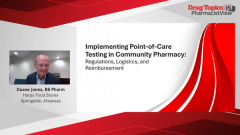
Q&A: Getting Started with Point-of-Care Testing in Community Pharmacy
A panelist discusses how medication synchronization programs are essential for implementing point-of-care testing by making half of prescription volume nonurgent, allowing pharmacists to delegate work and free up time for clinical services.
Episodes in this series

Q&A – Getting Started with Implementation
Main Discussion Topics:
- Initial steps for implementing point-of-care testing in community pharmacy
- Time management and workflow integration
- Pharmacist acceptance and adoption process
Key Points for Physicians:
- State regulations for pharmacy-based testing vary significantly; consultation with board of pharmacy is essential
- Pharmacies handling up to 900 prescriptions daily successfully integrate testing without additional staffing
- Medication synchronization programs create necessary capacity for clinical services
Notable Insights:
- The greatest initial challenge is often pharmacist comfort with new clinical roles
- Pharmacists typically report high satisfaction with expanded clinical services once these are implemented
- Delegation to pharmacy technicians is essential for successful integration
Clinical Significance:
Implementing point-of-care testing requires initial workflow redesign and staff training but creates sustainable clinical service opportunities that enhance professional satisfaction while improving patient access to care.
Newsletter
Pharmacy practice is always changing. Stay ahead of the curve with the Drug Topics newsletter and get the latest drug information, industry trends, and patient care tips.



































































































































